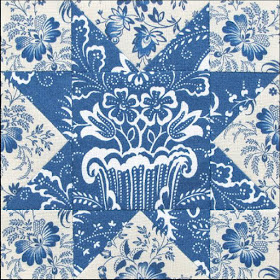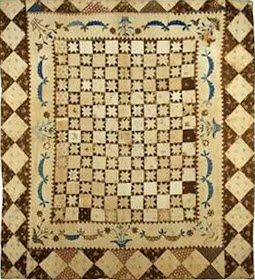18th-century quilts might feature these large-scale indigo prints fashionable for furnishings.
An 18th-century period room at the Shelburne Museum shows
the scale of early indigo prints. From a vintage postcard.
The scale on these bed hangings is enormous,.
Printing figures with indigo is difficult to do and to understand. We could go into the various ways these blue and white furnishing prints were produced but I'm not that sure what's a resist print, a discharged print, a block-printed design or one painted by hand. Experts wonder if they are domestically produced or imported from Europe or India.
So let's just focus on getting the look.
People wore them for clothing. Above a
European woman in traditional rural dress but fashionable
city dwellers wore these too.
Reproduction from Indigo Crossing by Minick & Simpson
This is an accurate copy of the vintage piece above.
Smaller scale though.
You are looking for large-scale blue and white prints, either navy blue or lighter blue.
Another take on the early indigo star by Becky Brown
Frame quilt from the Winterthur Museum collection.
This print is done in light blues and dark indigoes.
Several of the prints recur in various early textiles.
"Very old blue and white resist print"
Gift from Florence Peto to Elizabeth Richardson
Collection of Western Kentucky University
One characteristic is a certain crudeness to the print.
This one is atypically crude. Most are more skillfully done, but you tend to see large areas
of color with no fine detail.
The Metropolitan Museum of Art put this double blue on the cover of their Interwoven Globe textile
show last year.
If you are thinking of doing a quilt echoing the Revolutionary War period,
you might consider a wholecloth indigo print at a giant scale.
Reproductions
Indigo Crossings from Minick & Simpson reproduced the look
for quilters.
The designers with a strip quilt behind them showing the scale
of their largest print.
Midwest Crossings
Quilt kit and pattern by Jennifer Overstreet using the line
Nancy Gere's Low Country Indigo stars are
set with the large print from her line.
Stella Bella's block for indigo blue
has a bit of the scale of the old American indigo resist.
When you're working at 6" you can fool the eye as far as scale.
Reproduction block by Bettina Havig using a true indigo print
from Europe.
You may find it easier to buy upholstery fabric for these early indigos
Tucker resist by Waverly
A den in colonial style.
Those period rooms (see the top of
the page) continue to define traditional interiors:
Gate-leg tables, red Oriental rugs and indigo drapes.
Batik Indigo from P. Kaufman
The upholstery fabric costs about twice as much as quilt fabric
but you don't need much to add an early period look to your stars.
And remember it's wider.
What to Do with Your Stack of Stars?
Stitch a Field of Patchwork.
The Sarah Johnson quilt by Barb Perrin
When these indigo prints were the rage in the late-18th century
quilters tended to focus on a central image floating in a sea of patchwork.
Hoopla pattern for this Shelburne Museum quilt repro
When Sarah Johnson made the original, dated 1828,
she used the same sawtooth star we are using.
A sketch in EQ7 of 72 six-inch stars around a center finishing to 18".
54" x 54"
Kensington Square by Val Naden reproduction
Val's focus was the John Hewson panel
by Kathy Hall.
1811 Hewson quilt, Cincinnati Art Museum
The panel was inspired by Hewson's block-printed design with vase, birds and butterflies.
The quilt above alternates stars with plain blocks for the patchwork field.
The field of patchwork with a central focus is a signature design in early quilts.
Quilt dated 1815. Rhode Island Project. Quilt Index photo.
This early quilt has a very small center focus in a field of patchwork nine-patches. Is that center white
square one of the Hewson Butterflies?
Anna Tuel's Quilt, 1785, Wadsworth Atheneum
The field was often simple triangles.
Quilt dated 1806, Delaware Historical Society
But simple stars are also seen quite early.
Di Ford's Miss Porter's Quilt echoes a quilt dated in the 1770s.
Quilt signed R Porter,
Collection of the American Museum in Bath
Some recent quilts inspired by early design ideas:
Bettina Havig, Feathered Star Medallion
Leonie Bateman and Deirdre Bond-Abel for their
Elegant Quilts, Country Charm book
Lizzy Mae's Medallion by Lori Smith
Whose pattern?
Dawn Heese's version of a Blackbird Design.
Update the look by placing the focus to one side. Offset symmetry is a characteristic of Blackbird's designers Barb and Alma.
I found this one on Laura Nagel's Pinterest board.
One More Thing about Early Indigoes
The International Quilt Study Center and Museum has an online show, Indigo Gives America the Blues, in which they explain various kinds of indigo printing.
They call this week's style
American Indigo Resist:
Mid to Late - 1700s










BOmFsyDKbg~~60_3.jpg)































Love the blue and white quilts. It's on my to do list.
ReplyDeleteMary
OMG - I just cut this fabric (Indigo Crossing) out this morning for my block print star. I guess maybe I need to rethink that. LOL
ReplyDeleteLove this post - The company that I work for, celebrating our 150th anniversary this year, started as one of the companies in Europe producing indigo dyes. So this one is very interesting to me! Thanks!
I loved the link! how fabulous that they shared the exhibition and information online thank you so much I wonder if this is a permanent link or temporary
ReplyDeleteI love indigo - and have some catching up to do in the Stars department! Thanks for another informative post!
ReplyDeleteI have toyed with the idea of buying one of the large scale early indigo decorating fabrics for years. I love them but they dominate a room. All the indigo repros I know of in dec weight fabric have a non-cotton fiber blended in. It would be hard to incorporate the heavier, blended decorating fabric into a 100% cotton broadcloth quilt. Maybe it would be great tho as a whole cloth quilted bedcover.
ReplyDeleteAwesome! Love the larger scale prints. I find them very beautiful and intimidating lol. I never know how to cut them and where to use them but I love them. Were the larger prints always indigo blue or did they came in other colours too?
ReplyDeleteTo Chantal-
ReplyDeleteYou see these prints in brown too. Off the top of my head I can't recall other colors---but if I did any research I bet I'd find some other shades.
To Debra-
They are both block prints and indigo prints. Indigo is the coloring agent; blocks are the technology to obtain the color.
The eagle & stars quilt you labeled "whose pattern" was published in Quilters' Newsletter circa 1998, if I remember correctly. I have it around here somewhere as I've been intending to make it. Not since 1998, I just discovered it in the last couple of years. I can look it up if you want the particulars.
ReplyDeleteSue in Marion, IN